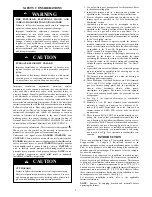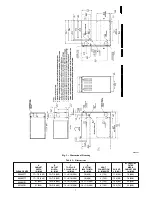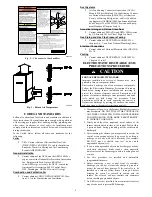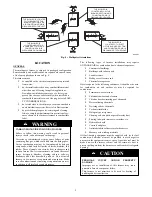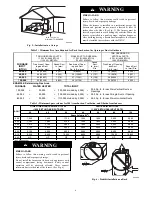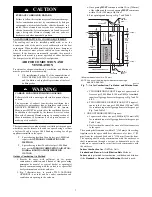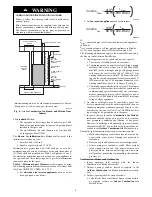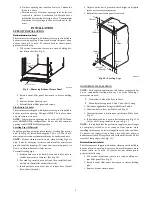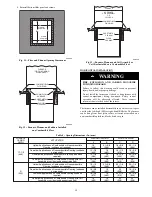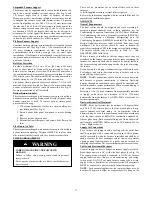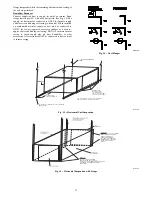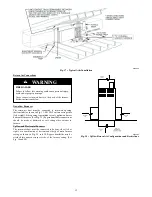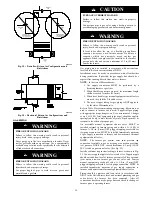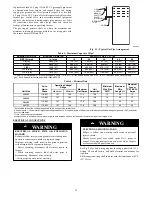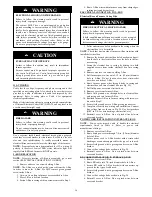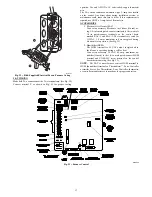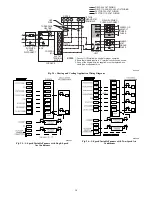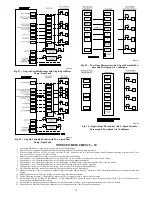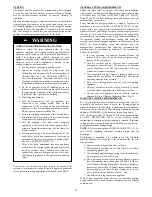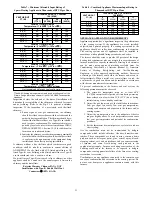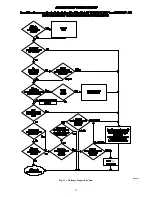
7
FURNACE CORROSION HAZARD
Failure to follow this caution may result in furnace damage.
Air for combustion must not be contaminated by halogen
compounds, which include fluoride, chloride, bromide, and
iodide. These elements can corrode heat exchangers and
shorten furnace life. Air contaminants are found in aerosol
sprays, detergents, bleaches, cleaning solvents, salts, air
fresheners, and other household products.
CAUTION
!
LOCATION RELATIVE TO COOLING EQUIPMENT
The cooling coil must be installed parallel with, or on the
downstream side of the unit to avoid condensation in the heat
exchangers. When installed parallel with the furnace, dampers or
other flow control must prevent chilled air from entering the
furnace. If the dampers are manually operated, they must be
equipped with means to prevent operation of either unit unless
the damper is in the full--heat or full--cool position.
AIR FOR COMBUSTION AND
VENTILATION
Provisions for adequate combustion, ventilation, and dilution air
must be provided in accordance with:
S
U.S. installations: Section 9.3 of the current edition of
NFGC NFPA54/ANSI Z223.1, Air for Combustion
and Ventilation, and applicable provisions of the local
building codes.
!
WARNING
CARBON MONOXIDE POISONING HAZARD
Failure to follow this warning could result in personal injury
or death.
The operation of exhaust fans, kitchen ventilation fans,
clothes dryers, attic exhaust fans or fireplaces could create a
NEGATIVE PRESSURE CONDITION at the furnace.
Make--up air MUST be provided for the ventilation devices,
in addition to that required by the furnace. Refer to Carbon
Monoxide Poisoning Hazard warning in venting section of
these instructions to determine if an adequate amount of
make--up air is available.
The requirements for combustion and ventilation air depend upon
whether or not the furnace is located in a space having a volume
of at least 50 cubic feet per 1,000 Btuh input rating for all gas
appliances installed in the space.
S
Spaces having less than 50 cubic feet per 1,000 Btuh
require the
OUTDOOR COMBUSTION AIR
METHOD.
S
Spaces having at least 50 cubic feet per 1,000 Btuh
may use the
INDOOR COMBUSTION AIR, STAN-
DARD or KNOWN AIR INFILTRATION
METHOD.
Outdoor Combustion Air Method
1. Provide the space with sufficient air for proper
combustion, ventilation, and dilution of flue gases using
permanent horizontal or vertical duct(s) or opening(s)
directly communicating with the outdoors or spaces that
freely communicate with the outdoors.
2. Fig. 7 illustrates how to provide TWO OUTDOOR
OPENINGS, one inlet and one outlet combustion and
ventilation air opening, to the outdoors.
a. One opening
MUST
commence within 12--in. (300 mm)
of the ceiling and the second opening
MUST
commence
within 12--in. (300 mm) of the floor.
b. Size openings and ducts per Fig. 7 and Table 2.
1 SQ IN .
PER
4000
BTUH*
DUCTS
TO
O UTDOORS
1 SQ IN.
PER 4000
BTUH*
C
IRCULA
TING
AIR DUCTS
VENT
THR OUGH
R OOF
D
B
A
C
E
1 SQ IN.
PER 4000
BTUH*
DUCT
TO
OUTDOORS
CIRCULA TING AIR DUCT S
1 SQ IN.
PER 2000
BTUH*
1 SQ IN.
PER 2000
BTUH*
DUCT S
TO
OUTDOORS
12
″
MAX
12
″
MAX
12
″
MAX
12
″
MAX
12
″
MAX
OUTDOORS
1 SQ IN .
PER
4000
BTUH*
F
G
CLEARANCE IN FRONT
OF COMB
USTION AIR
OPENINGS SHALL BE
AT LEAST 3 IN
.
(305mm)
(305mm)
(305mm)
(305mm)
(305mm)
(76mm)
*Minimum dimensions of 3 in. (76 mm).
NOTE: Use any of the following combinations of openings:
A&B, C&D, D&E, F&G
A03174
Fig. 7 -- Air for Combustion, Ventilation, and Dilution from
Outdoors
c. TWO HORIZONTAL DUCTS require 1 square inch of
free area per 2,000 Btuh (1,100 mm
2
/kW) of combined
input for all gas appliances in the space per Fig. 7 and Ta-
ble 2.
d. TWO OPENINGS OR VERTICAL DUCTS require 1
square inch of free area per 4,000 Btuh (550 mm
2
/kW)
for combined input of all gas appliances in the space per
Fig. 7 and Table 2.
3. ONE OUTDOOR OPENING requires:
a. 1 square inch of free area per 3,000 Btuh (734 mm
2
/kW)
for combined input of all gas appliances in the space per
Table 2 and
b. Not less than the sum of the areas of all vent connectors
in the space.
The opening shall commence within 12” (300 mm) of the ceiling.
Appliances in the space shall have clearances of at least 1” (25
mm) from the sides and back and 6” (150 mm) from the front.
The opening shall directly communicate with the outdoors or
shall communicate through a vertical or horizontal duct to the
outdoors or spaces (crawl or attic) that freely communicate with
the outdoors.
Indoor Combustion Air
-- NFPA & AGA
Standard and Known--Air--Infiltration Rate
Methods
Indoor air
is permitted for combustion, ventilation, and dilution,
if the
Standard
or
Known--Air--Infiltration
Method is used.


